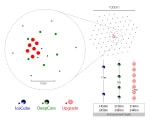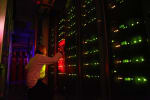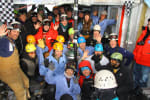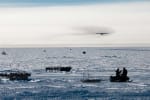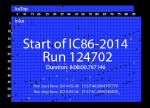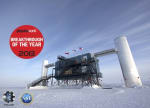The IceCube-Gen2 Collaboration recently wrapped up a weeklong kick-off meeting to formalize a technical design report for the project. With over 100 participants and 50 talks, the interdisciplinary workshop brought together scientists and engineers from around the world to discuss the status of design and performance requirements that will lay the foundation for IceCube-Gen2’s technical […]
Detector
Celebrating IceCube’s first decade of discovery
It was the beginning of a grand experiment unlike anything the world had ever seen. Ten years ago today, the IceCube Neutrino Observatory fully opened its eyes for the first time. Over the course of the previous seven years, dozens of intrepid technicians, engineers, and scientists had traveled to the South Pole—one of the coldest, […]
IceCube-Gen2 will open a new window on the universe
In a white paper recently submitted to the Journal of Physics G, the international IceCube-Gen2 Collaboration outlines the need for and design of a next-generation extension of IceCube. By adding new optical and radio instruments to the existing detector, IceCube-Gen2 will increase the annual rate of cosmic neutrino observations by an order of magnitude, and its sensitivity to point sources will increase to five times that of IceCube. […]
IceCube Upgrade for precision neutrino physics and astrophysics kicks off
The launch of the so-called IceCube Upgrade—which will deploy seven new strings at the bottom of the detector array—sets a milestone in what IceCubers have designed as an incremental extension of the Antarctic detector. […]
NSF renews IceCube maintenance and operations contract
The National Science Foundation today, March 30, 2016, announced that it has renewed a cooperative agreement with the University of Wisconsin–Madison to operate IceCube. The five-year, $35 million award entails the continued operation and management of the observatory located at NSF’s Amundsen-Scott South Pole Station. In 2013, the IceCube Collaboration reported the first detection of high-energy cosmic neutrinos, opening a new astronomical vista on the universe and on some of its most violent phenomena. […]
Five years since IceCube Neutrino Observatory completion
Decades ago, the aspiration to build a kilometer-scale neutrino detector at the South Pole seemed farfetched; today, we celebrate the 5-year anniversary of this incredible achievement. Shortly after 6 pm New Zealand time on December 18, 2010, the final sensor was lowered into the ice. This completed the decade-long construction effort that started with the design and fabrication of detector systems and concluded with the installation of the final string of sensors. […]
Drilling IceCube: a story of innovation, expertise and strong will
Building a cubic-kilometer telescope at the South Pole seemed a chimera even for some of those involved in the project. The goal was simple in words but seemingly impossible in practice: 86 boreholes, each 60 cm in diameter and 2,500 m deep, had to be drilled and instrumented in seven austral summer seasons. Safety was a must, fuel needed to be used cautiously and the South Pole environment was just unavoidable. […]
A new polar season for IceCube
After a long winter, South Pole inhabitants are getting used to the sunlight again. Up north, a bunch of IceCubers are getting ready for their Antarctic adventure. For some of them, it’s all about the excitement of a first trip to Antarctica. For some others, it’s an almost annual appointment that makes their job a special one. […]
The start of the IC86-2014 physics run
Around mid-May each year, new detector configurations are applied to IceCube to keep up its performance and to improve scientific results. Last week, on May 6, the IC86-2014 physics run was launched. […]
IceCube awarded the 2013 Breakthrough of the Year
The IceCube project has been awarded the 2013 Breakthrough of the Year by the British magazine Physics World. The Antarctic observatory has been selected for making the first observation of cosmic neutrinos, but also for overcoming the many challenges of creating and operating a colossal detector deep under the ice at the South Pole. […]



